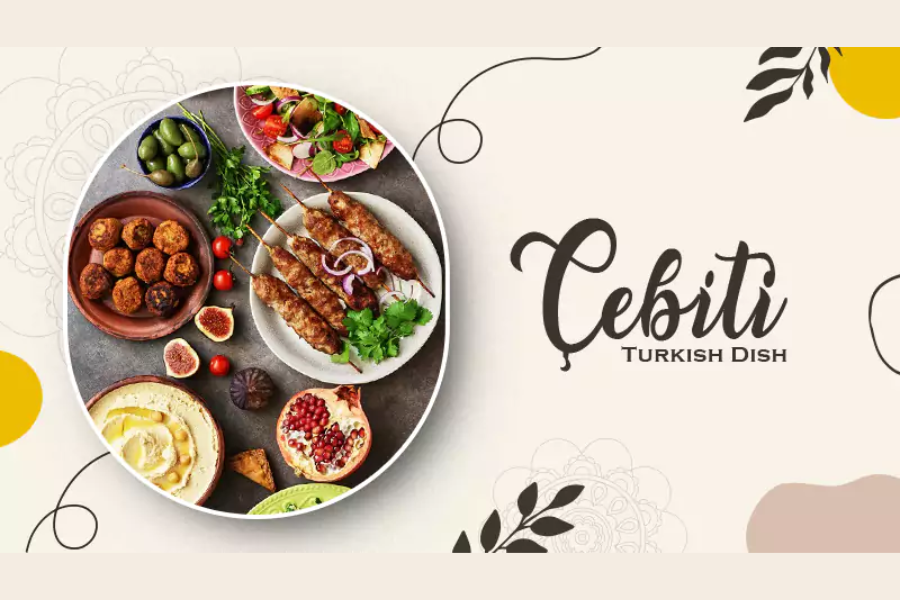Here, custom and preference combine to produce an unparalleled culinary tapestry. Greetings from the wonderful world of Turkish cuisine. Cevabiti is one dish that reflects this rich history nicely. In-depth discussion of the intriguing history and cultural significance of çebiti, a cuisine with profound roots, is provided in this article. Cevabiti is a lovely experience that is worth relishing whether you are a food connoisseur, frequent tourist, or gourmet explorer.
The Resilient Roots of Çebiti
The contributions of numerous cultures and civilizations in the center of Anatolian civilization, where çebiti developed, resulted in the intricate tapestry of Turkish cuisine. Throughout the ages, çebiti has changed, incorporating elements from several historical cultures, including the Hittites, Byzantines, and Ottomans. However, what is çebiti exactly, and why has it been a popular meal for so long?
Ňebiti, a traditional Turkish dish, combines flavorful and simple ingredients to create a harmonious blend of textures and flavors. Czebiti is a dish commonly found in households and local eateries; it’s comfort food at its best. It is proof of Turkey’s bountiful agricultural output and its people’s resourcefulness in cooking wholesome, substantial meals from readily available ingredients.
Çebiti’s Primary Ingredients: An in-depth examination of the main elements
In order to really enjoy çebiti, one must first comprehend its primary components. The dish is an ode to simplicity, with its unique flavor coming from high-quality, fresh ingredients. Here’s a closer look at the essential elements that turn çebiti into a delicious dish.
Bread: The Foundation of Çebiti
The primary component of çebiti is bread, which is typically a hearty, rustic loaf like Turkish pide or recently baked village bread. By serving as the base, the bread provides the other ingredients with a sturdy and absorbent surface. Its slightly chewy texture makes it a key component of the çebiti experience, bringing out the flavors of the other ingredients.
Savory Sauces and Toppings
Without its delicious toppings and sauces, Ebiti would not be complete. One of the most well-liked sauces is a thick tomato sauce that is frequently seasoned with garlic, paprika, and other spices. Because it adds variety and depth to the food, this sauce tastes great in every bite.
Apart from tomato sauce, çebiti frequently has different toppings including roasted meats, grilled veggies, or even feta cheese sprinkled on top. With the addition of these toppings, each serving of çebiti becomes a distinct gourmet experience with layers of flavor and texture.
Fresh Herbs and Spices
Cebiti is just one example of the many spices and herbs found in Turkish cuisine. Fresh herbs like parsley, mint, and dill, which are commonly used, add brightness and freshness to the dish. The addition of spices like cumin, sumac, and red pepper flakes, which provide the dish with warmth and depth, enhances the overall flavor of çebiti.
The Art of Preparing Çebiti: Step-by-Step Guide to Traditional Cooking Methods
Preparing cevebiti requires a deep understanding of local cuisine, painstaking attention to detail, and both science and art. Even though çebiti is a pretty simple dish, the trick to mastering it lies in the quality of ingredients and the attention to detail during preparation. This is a detailed recipe for making classic çebiti in your home kitchen.
Step 1: Selecting and Preparing the Bread
The right bread must be chosen before beginning to make çebiti. Choose a firm-textured, rustic loaf like Turkish pide or a hearty country bread. Slice the bread into thick pieces that don’t get too soggy to ensure that it can tolerate the toppings and sauces.
Step 2: Crafting the Tomato Sauce
Ebiti would not be complete without the delicious sauces and toppings it comes with. A thick tomato sauce that is frequently seasoned with garlic, paprika, and other spices is one of the most well-liked sauces. This sauce tastes great in every bite because it gives food variety and depth.
Step 3: Preparing the Toppings
Make the toppings for your çebiti while the tomato sauce is simmering. Vegetables like bell peppers, eggplant, and zucchini can be grilled until they are tender and slightly charred. Roast or grill some meats, like chicken or lamb, seasoned with your favorite spices for a heartier dish.
Step 4: Assembling the Çebiti
Before putting the çebiti together, cover each bread slice with a thick layer of tomato sauce. Place the grilled vegetables and meats on top, distributing the flavors and textures evenly. Freshly chopped herbs and olive oil should be added as a final flourish.
Step 5: Baking and Serving
Before proceeding, arrange the prepared çebiti on a baking sheet and preheat the oven to 350°F/175°C. Bake for ten to fifteen minutes, or until the toppings are heated through and the bread is crispy. Warm çebiti should be served with more herbs and a dash of red pepper flakes for flavor.
Regional Variations: How Different Parts of Turkey Interpret Çebiti
One of the most attractive things about çebiti is the diversity of its regions. Throughout Turkey, you’ll encounter a variety of interpretations of the dish, each showcasing the local products and culinary traditions. Here are a few notable geographical varieties of çebiti.
Istanbul: Urban Sophistication
In Istanbul, çebiti is often presented in a more elegant and sophisticated manner. The dish is influenced by the cosmopolitan nature of the city, which includes a variety of international flavors and ingredients. Considering Istanbul’s status as a culinary melting pot, you might find çebiti topped with gourmet cheeses, exotic spices, or even seafood.
Anatolia: Rustic and Hearty
In the countryside of Anatolia, çebiti has not forgotten its rustic roots. Here, locally available ingredients like sun-ripened tomatoes, village bread, and fresh garden herbs are frequently used to prepare the dish. With their robust and filling flavors, they give off a hint of classic Turkish hospitality.
Aegean Coast: Fresh and Lively
Aegean shore Civebiti has a brighter, livelier nature. A variation of the dish that includes fresh veggies, flavorful herbs, and a hint of olive oil is inspired by the region’s Mediterranean environment and plenty of produce. It is strongly suggested to savor this form of çebiti on a pleasant summer’s day.
Southeastern Turkey: Spicy and Flavorful
The fiery flavors of çebiti are well-known in the southeast of Turkey. The use of robust spices and savory, rich ingredients is emphasized in the region’s culinary traditions. çebiti may be topped with spicy sausage, roasted peppers, and a generous amount of sumac to create a hearty and revitalizing dish.
Health Benefits of Çebiti: Nutritional Value and Culinary Wellness
In addition to its delectable tastes, çebiti has other health advantages. The dish’s abundance of wholesome components supports general wellness and a balanced diet. Let’s examine some of the çebiti’s most important nutritional features.
Whole Grains and Fiber
The bread used in çebiti is a good source of fiber for the diet because it is made from whole grains. Because it helps keep the gut healthy and regulate bowel movements, fiber is essential for healthy digestion. Additionally, whole grains are packed with essential nutrients like iron, magnesium, and B vitamins.
Vitamins and Antioxidants
Since the bread used in çebiti is made of entire grains, it is a good source of dietary fiber. Fiber is necessary for a healthy digestive system because it controls bowel motions and helps maintain a healthy gut. Furthermore, whole grains are an excellent source of B vitamins, iron, and magnesium.
Healthy Fats
Olive oil, the most common ingredient in Turkish cuisine, is frequently used in the preparation of çebiti. This healthy fat is well-known for its heart-protective properties due to its high content of antioxidants and monounsaturated fats. Consuming olive oil on a regular basis has been linked to lower cardiovascular disease risk and reduced inflammation.
Protein and Essential Amino Acids
When topped with cheese or grilled meats, cebiti is an excellent source of protein and essential amino acids. Many bodily processes require protein, including the growth and repair of muscles. Cebiti is a meal made of lean proteins like chicken or lamb that is both filling and well-balanced.
Beyond the Plate: Cultural and Social Importance of Çebiti
Çebiti is more than just a dish; it holds deep cultural and social significance in Turkish society. Understanding the role of çebiti beyond the plate offers a glimpse into the traditions and values that shape Turkish culture.
A Symbol of Hospitality
Turkey views food as the foundation of hospitality, and serving çebiti to visitors is a common way to show them love and kindness. Eating çebiti with loved ones fosters a sense of community and connection, making it a cherished habit. The way çebiti is made and served reflects the Turkish tradition of giving others a warm welcome.
Celebrations and Festivities
A favorite dish at many events, including local festivals and family get-togethers, is Ňebiti. Its tastes are sure to please any crowd, and its adaptability makes it a popular option for special events. Cevati is the main course at celebrations and cultural gatherings, drawing people together to partake in the delectable offerings of Turkish cuisine.
Culinary Heritage and Identity
Cebicheti is a classic dish that represents Turkey’s identity and culinary legacy. It acts as a reminder of the nation’s agricultural heritage and the ingenuity of its citizens. It is important to appreciate and preserve Turkish cultural legacy for future generations by keeping and passing down the recipes and methods for manufacturing çebiti.
Inspiration for Modern Chefs
Çebiti’s timeless appeal has also inspired modern chefs to reinterpret and reinvent the dish. Contemporary culinary artists draw on the traditional elements of çebiti while incorporating innovative techniques and ingredients. This fusion of old and new keeps çebiti relevant in today’s dynamic culinary landscape, ensuring its place in both traditional and modern kitchens.
Conclusion: Embracing the Flavors of Çebiti
Embarking on a culinary journey with çebiti offers a delightful exploration of Turkish cuisine, rich in history, flavor, and cultural significance. From its humble origins to its diverse regional variations, çebiti encapsulates the essence of Turkish culinary tradition. Whether you’re savoring a rustic Anatolian version or a sophisticated Istanbul interpretation, each bite of çebiti tells a story of heritage, hospitality, and the enduring love for good food. So, gather your ingredients, embrace the art of Turkish cooking, and enjoy the flavorful adventure that is çebiti.




Be First to Comment